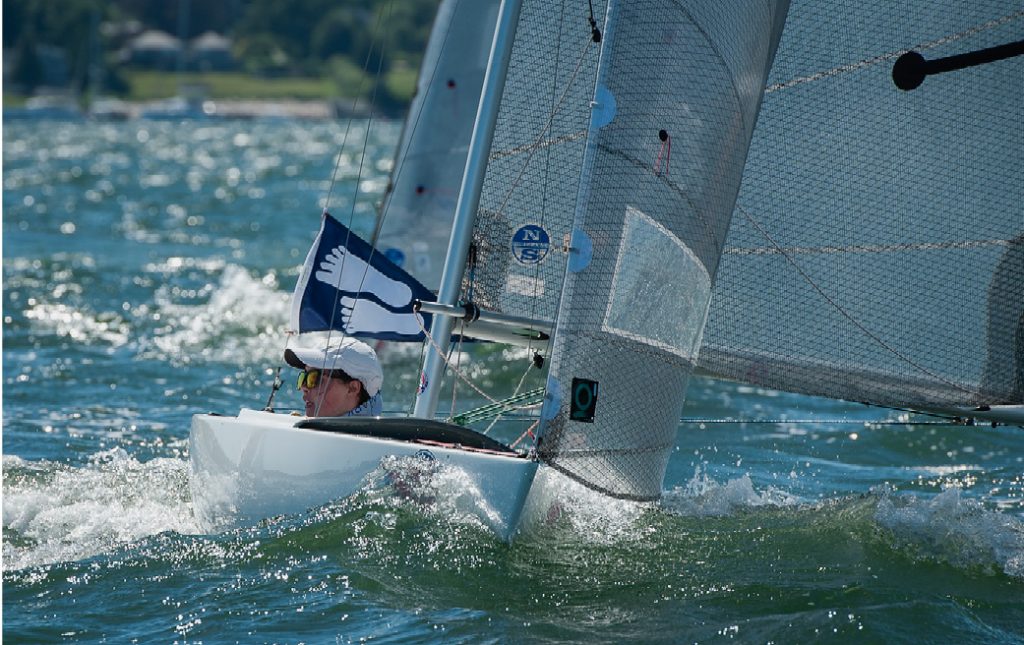When your position in the race suddenly takes a nose dive, it’s time to re-focus your gameplan. Don’t discard your well-planned strategy, but consider making a few adjustments.
Take a deep breath. Before you follow a knee-jerk reaction (which seldom works), pause for a moment and assess your situation. Think about questions like:
• Is it early or late in the series?
• Do you already have a throwout?
• How good is your boatspeed?
• How confident are you in your pre-start strategic plan?
The answers will tell you a lot about how much risk you are willing to take in order to improve your position in the race. If you already have a bad race as your throwout, for example, you can’t risk getting another one.
Evaluate your risk tolerance. At any moment in a race, especially when you are back in the pack, you must decide how much risk to take. Are you willing, for example, to go on a flier out to one corner? This will give you lots of leverage to catch up, but it also increases your chances of falling farther behind.
When it’s relatively early in a race or series, you should generally take fewer risks. Try to sail fast, use smart boat-on-boat tactics, and choose strategic options that have a high probability of success.
As you get closer to the finish (of a race or series), however, it’s a different story. That’s when you can (and should) consider taking larger risks to get the points you need.
For example, let’s say you are sailing up the windward leg. Most of the fleet is going left, and you figure there is about a 1 in 3 (33%) chance the right side will pay off. Those odds are probably not high enough to go there on the first beat, but if you’re still doing poorly on the last beat, you might roll the dice and give that side a try.

Team Clagett member Siobhan MacDonald (Toronto, ONT) is competing in the 23rd Annual C. Thomas Clagett, Jr. Memorial Clinic and Regatta at Sail Newport this month (perhaps the finest volunteer opportunity in Newport sailing Ed.), and representing Clagett Sailing at the 2025 2.4mR World Championship in Lake Garda, Italy in October. © Clagett Sailing/Andes Visual
Minimize mistakes. Avoiding errors is a good idea no matter where you are in the race, but it’s especially important when you’re behind. At the front of the fleet, the boats are farther apart. So if you take a chance that doesn’t work, the cost is not so great. But when you’re fighting with other boats you don’t have the same safety net.
The best comeback strategy is usually to minimize the number of mistakes you make. First of all, don’t go for an impulsive reaction when you fall behind – instead, be patient and thoughtful about your options. Avoid taking big chances, and be ready to pass the boats ahead when they make errors.
Keep the big picture in mind. Remember your goal is to catch as many boats (or gain as much time) as you can before the finish, so don’t get obsessed with just one or two other boats. That is, don’t lose sight of the forest for the trees.
Especially when it’s early in the race, making up distance may be more important than gaining places. On a reach, for example, it’s often better to stay in 15th place and gain distance on the leaders than to go high and pass a boat or two but lose distance to every other boat ahead.
In most situations, it’s not possible to make up your deficit all at once. Sure, we occasionally hear stories where someone bangs the corner and goes from 20th to first. But that is the exception rather than the rule.
It’s generally better to be conservative and methodical, picking up one or two boats at a time. This approach means you go for a lot of small high-probability gains rather than one large low-probability gain. In other words, be like the tortoise instead of the hare.
Focus on strategy or tactics?
When you are playing catch up, another choice you must make is whether to focus on strategy (windshifts) or tactics (other boats). Both are important, but the relative balance depends on where you are in the race. If it’s just after the start, for example, don’t worry about one or two other boats. Play your best strategic cards to gain distance on the entire fleet.
As you get closer to the finish, however, the boats are more spread out and you don’t have time to make large strategic gains. That’s when you should shift into tactical mode and make sure you beat all the boats around you. ■
This article originally appeared in David Dellenbaugh’s Speed & Smarts, The newsletter of how-to tips for racing sailors. If you want to sail faster and smarter, log onto SpeedandSmarts.com.
A resident of Easton, CT, Dellenbaugh was tactician and starting helmsman for America3’s successful defense of the America’s Cup in 1992. He’s a Lightning World Champion, two-time Congressional Cup winner, seven-time Thistle National Champion, two-time winner of the Canada’s Cup, three-time Prince of Wales U.S. Match Racing Champion, and a winner of the U.S. Team Racing Championships for the Hinman Trophy.

